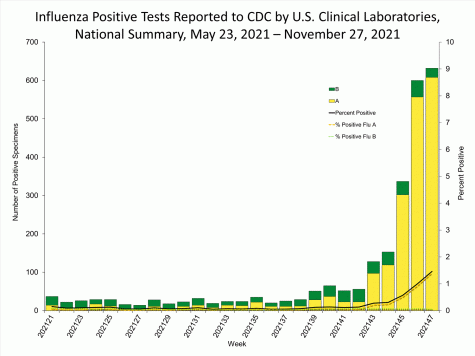As COVID-19 Restrictions Decrease, Flu Infections May Rise
December 6, 2021
During the COVID-19 pandemic, the rate at which people caught the flu was unusually low due to measures taken to combat Coronavirus such as social distancing, reduced travel and school closures.
It’s predicted that by January, however, this school year will entail a flu season worse than ones seen before.
Being socially distanced and cautious for nearly two years means that besides COVID-19, most people were not exposed to illnesses such as the typical influenza or cold virus.
This information means the flu could affect people more severely than it typically would as a result of having virtually no immuno-exposure for an entire season.

In fact, a study from the University of Pittsburg said that based on a prediction model, “if flu and flu vaccination levels are typical of prior years, 102,000 more Americans than average could be hospitalized with influenza — a 20 percent increase.”
This statistic combined with the decreasing effectiveness of COVID-19 vaccines means flu season this year could have major implications at school in terms of attendance.
The school’s clinic assistant Cameron Gaines, however, said she isn’t worried about students and staff as long as the community continues to stay “germ-conscious” by wearing a mask and keeping their hands clean.
Gaines also said it can be hard to differentiate between flu symptoms and COVID-19 symptoms since the latter is so broad. Some of the symptoms shared between the flu and COVID include aches and pains, stuffy or runny nose, fever, cough and exhaustion. She said those with symptoms should see a doctor either way.
Students have some fears about this flu season.
Senior Soahum Shah said going through the flu in 2017 was an uncomfortable experience he wouldn’t want other people to suffer through.
Similarly, Senior Liora Yehuday said she thinks “because of COVID, people are forgetting the flu exists, which is a huge concern because of how easily it spreads in schools.”
One way to avoid catching the flu is by getting the vaccine, which typically has a 40%-60% effectiveness rate.
Something to consider, though, is flu vaccines are typically modeled after the previous year’s strain and infection patterns. Because 2020 saw unusually low levels of flu exposure, it may be less effective than in previous years.
Despite this, a 2021 study showed that among adults, flu vaccination was associated with a 26% lower risk of ICU admission and a 31% lower risk of death from flu compared to those who were unvaccinated.
Some other ways to avoid catching the flu includes using personal protective measures such as washing hands often, using hand sanitizer, and wearing a mask.

Trisha Paytas • Dec 6, 2021 at 2:24 pm
slayyyyyyy!!!!!!!